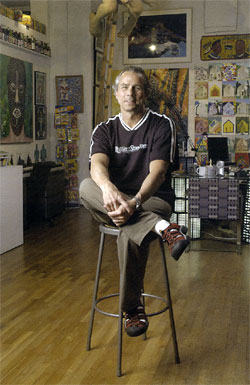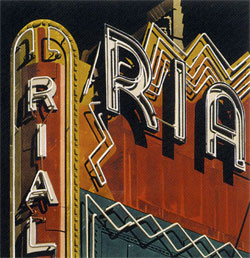|
Howard Tullman, A Chicago Collector By Burke Patten
The bulk of the photorealist works were first seen by Howard Tullman at a group exhibition at the New York gallery OK Harris Works of Art. "The show was a unique situation where all of these photorealist masters did comparably sized watercolors that made it possible to compare and study their work in a very interesting way," Tullman recalls, adding that he decided then and there to buy all the works in the show. The art world knows Tullman as both a collector of contemporary work and a benefactor of museums. The business world knows him as a savvy entrepreneur, harnessing new media's potential and reinvigorating educational institutions. Tullman launched the online music site Tunes.com in the late 1990's and currently serves as chairman of the board of Cobalt, an Internet Service Provider for automotive dealers. In the education field he recently served as president of Chicago's Kendall College, which he steered out of financial trouble and relocated from Evanston to new state-of-the-art facilities on Goose Island, a neighborhood on Chicago's Near North Side. Tullman's passion for art is integrated into all areas of his life. In addition to the work displayed in his home, Tullman's loft in downtown Chicago is wall-to-wall art. "It makes the whole working environment richer and warmer," he says. There's something to study, contemplate, or just admire wherever you look. Paintings, drawings, prints, sculptures, and other three dimensional works occupy every wall and table space. His collection of Pex candy dispensers and vintage coin banks and lunchboxes fill in whatever space remains. Enhancing the workplace extends to Kendall's campus, where Tullman has hung art from his collection in classrooms, offices, and hallways. "Having the art work around has been a very important part of our vision for the 'new' Kendall College, where we are really trying to combine technical and aesthetic qualities in all that we do," he explains. "It has a profound impact on the overall atmosphere of the college." To date, the Tullmans have donated about 30 works (roughly totaling half a million dollars) to about 12 art museums including the Block, the Milwaukee Art Museum, the Madison Museum of Contemporary Art in Wisconsin, and the Frye Art Museum in Seattle. Insititutions generally request works the Tullmans have collected, and the Tullmans then decide whether they can part with them. Tullman began collecting art in the 1960s; his first acquisition was a drawing by Beth Shadur, a Chicago artist who creates visual narratives in a realist style. Paschke, Wirsum, Richard Bosman, Alfred Leslie, Jane Hammond, Robert Schultz, Fred Stonehouse, and Bill Vuksanovich are just a few of the artists represented in the Tullman collection, which he now estimates at about 1,000 works. He's drawn to figurative and realist art, he says, because "it's easy to understand and appreciate the obvious skill and not hard to set aside work that simply isn't first rate." (Tullman keeps a list of his collection online at www.tullman.com.) With more than 30 years of experience as an art collector, Tullman has seen changes in the Chicago art scene. He bemoans what he sees as a lack of young collectors in today's Chicago market and he says he's "pretty discouraged about the inability... to mount a major annual art show in Chicago... in part due to the fact that many of the collectors are doing their major buying elsewhere." But he's encouraged that the Merchandise Mart has agreed to take over the troubled Art Chicago, since "the decline in the last few years in the art show definitely sucked a lot of the energy and excitement out of the local market." Given Tullman's business skills, one might assume that he approaches acquisitions as asset builders. But Tullman says he makes purchase decisions based on aesthetics alone. "The only consideration on price is generally whether I feel it's realistic given the artist's age, experience, etc.," he says. "We don't regard this as an investment process. We essentially buy what we like and are excited by." So do the Tullmans always agree on what to buy? No, says Tullman, but they have a creative way to work out disagreements, which are "typically resolved by deciding where the pieces should be hung." And to date they haven't disagreed over donations, but, he adds, certainly we each have pieces that we don't want to part with."
Burke Patten, Communications Major |




